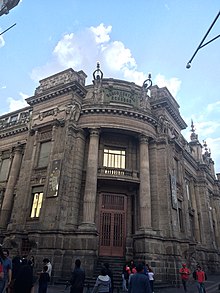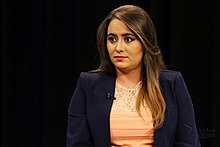Central Bank of Ecuador
 Logo of the Central Bank of Ecuador | |
| Headquarters | Quito |
|---|---|
| Established | 10 August 1927 |
| Ownership | 100% state ownership[1] |
| General manager | |
| Central bank of | Ecuador |
| Currency | None1 |
| Reserves | 2 020 million USD[1] |
| Website | www |
| 1Previously Ecuadorian sucre (ECS) until March 2000. | |
The Central Bank of Ecuador (Spanish: Banco Central del Ecuador (BCE)) is the central bank of Ecuador. It was the issuer of Ecuadorian sucre money until dollarization in 2000.
The Revolución Juliana (July 9, 1925) initiated the process of founding a national bank issuer. The country's crisis, caused by non-convertibility of the currency, banknote printing without reserves to support the increase in currency, inflation, speculation, abuse of credit, unbalanced payments, lack of official control over the banks and banking anarchy and strife, required cleaning up the currency situation. Current general manager is .[2]
| Economy of Ecuador |
|---|
 |
| Overview |
| Ecuador topics |
|
Foundation[]
The Central Bank of Ecuador is the organization created to meet these goals, within a patchwork of reforms of the Ecuadorian economy advocated by the military and civilians who supported Julian ideas. However, as the exchange rate and monetary regime are extremely sensitive in a small open economy like Ecuador's, the proposal had to evolve and overcome the inertia of social sectors uninterested in progress of that nature. An intermediate step was the creation of the Central Fund of Issue and Redemption on June 26, 1926, which oversees debt repayment and temporarily authorizes the circulation of banknotes.
On October 18, 1926, President Isidro Ayora declared that banks authorized to issue banknotes must hand over to the Central Fund specified quantities of gold and silver which, in total, amounted to ten million six hundred thousand sucres. Meanwhile, the mission headed by Edwin W. Kemmerer prepared a comprehensive economic overhaul, which modernised Ecuador's financial practices. Kemmerer was chosen for this task as he had successfully performed similar tasks in other countries in South America.
On February 11, 1927, the Kemmerer mission presented their findings to the Government Bill of the Central Bank of Ecuador, together with an explanatory memorandum. They suggested a corporation licensed for 50 years to issue money, discounted at a fixed rate, become a repository of government and member banks, manage the foreign exchange market and serve as fiscal agent for the country as a whole. Because the functions of the new institution were "closely linked to the sovereign rights of the Government and the public interest, the Government was asked to participate in his administration.
On March 12, 1927, the President Isidro Ayora enacted the Organic Law of Central Bank of Ecuador (Official Register No. 283). The preparation of the functioning of the new institution was in charge of an Organizing Committee, appointed by himself Ayora.
On 3 June 1927, Ecuador approved the statutes; they negotiated between the two agencies, and overcame difficulties between the Central Fund Release and the new institution finally on August 10, 1927 the Central Bank of Ecuador opened its doors. On 25 August 1927, Main Branch opened in Guayaquil.
Evolution[]
The new institution's first task was to stabilize and unify the currency. To achieve this, the Issuer Institute won the "gold standard exchange", a monetary system set the price of the sucre in terms of gold; their basic objective was to keep the price of the sucre fixed at 0.300933 grams of fine gold, or one fifth of the fine gold content of the U.S. dollar at that time. This convertibility forced an economic crisis when the United States entered its Great Depression (1929), which led to enact a new moratorium on payments on February 8, 1932.
Since then, the traditional policy of deficit spending and credit, which funded the Ecuadorian economy between 1915 and 1925, regained its validity.
Reforms[]
After the depression of 1929[]
Price instability driven by government spending and expansionary monetary policy forced the country to resort to another consultant, Manuel Gómez Morin, to reform the Central Bank Act and related monetary policy. Gómez Morin advised monetary authorities to channel credit to sectors of the economy deemed critical in the development process. Along with Victor Emilio Estrada, prominent Guayaquil banker, advised the Banco Central del Ecuador axis to determine the types of loans offered by private banks to the productive sector and changing the discount rate (1937). The difficulties in implementing the recommendations of Gomez Morin were immense. However, since then the relations between the government and banks were deeply modified.
After World War II[]
After World War II ended, a new surge in inflation, together with an imbalance of payments rendered it necessary, once again, to bring in foreign experts. In 1948, the manager of the Issuer Institute, Guillermo Perez Chiriboga, and Robert Triffin, from the Federal Reserve System of the United States, were called in to assist. Harvard's consultant proposed to replace the Central Bank Law and the Law of the Monetary and Foreign Exchange Law. This would require instituting a Directory of Ecuador Central Bank as an arm of the government, thereby making it responsible for overseeing national financial matters and giving it the power to devalue the currency, also to run countercyclical policies. The Issuer Institute was authorized to give loans to the state and the industrial sector, and finally, an accounting system was instituted that allowed them to assume the new functions. This was presented as the final goal of price stability and the preservation of sound financial standing.
After the upsurge of Debt[]
For more than three decades, this monetary regime successfully faced many shocks. However, the extent of the external debt crisis unleashed in 1981, the adjustments necessary to bring an unbalanced economy back into equilibrium, fiscal pressures, unbridled inflation and, above all, the need to reorder the whole economy to return to a more appropriate growth path, made yet more drastic changes necessary. To this end, in May 1992, the government issued the Law of Monetary Regime and State Bank, whereby the Central Bank of Ecuador was able to intervene in the financial system through open market operations. With this powerful instrument of policy, it has been possible to control inflation, unprecedented in the monetary history of Ecuador. Additionally, the need for new commitments for public sector austerity forced to violate the power to grant credit to the Treasury. Finally, in order to protect the interests of customers of the banking system, the Central Bank of Ecuador was authorized to operate as a lender of last resort, within strict financial parameters. It is clear now that the primary commitment of an institution of issue is to ensure price stability and external viability.
Presidents / General managers until 2013[]

- , 1927[3]
- , 1927-1929[4]
- , 1929-1932[4]
- , 1932[4]
- , 1932-1933[4]
- , 1933-1936[4]
- , 1936[4]
- , 1936-1937[4]
- , 1937[4]
- , 1937-1938[4]
- , 1938[4]
- , 1938-1939[4]
- , 1939-1940[4]
- , 1940-1944[4]
- , 1944[4]
- , 1944-1960[3][4]
- , 1960-1963[4]
- , 1963-1966[3][4]
- , 1967-1969[4]
- , 1969-1972[4]
- , 1972[4]
- , 1972-1973[4]
- , 1973-1976[4]
- , 1976[4]
- , 1976-1979[5][4]
- , 1979[5][4]
- , 1979-1981[5][6][4]
- , 1981-1984[5][4]
- , 1984-1987[7][4]
- , 1987-1988[8][4]
- , 1988-1990[9]
- , 1990-1991[10]
- , 1991-1992[11]
- Ana Lucía Armijos, 1992-1993
- , 1993-1996-?[12][13]
- , ?-1997-1998-?[14]
- , ?-1999-?
- , ?-2000-?[15]
- , ?-2001[16]
- , 2001-2004[17]
- , 2004[18]
- , 2004-2005[19]
- , 2005-2006[20]
- , 2006-2008[21]
- , 2008[22]
- , 2008-2009[23]
- Diego Borja, 2009-2011
- Pedro Delgado Campaña, 2011-2012
- , 2012-2013
- , 2013,[24] Last president of the bank[25]
General managers from 2013[]

Financial inclusion[]
The Bank is engaged in developing policies to promote financial inclusion and is a member of the Alliance for Financial Inclusion.[29] On April 26, 2012, the Banco Central del Ecuador announced it would be making specific commitments to financial inclusion under the Maya Declaration.
See also[]
References[]
- ^ Jump up to: a b https://d-nb.info/1138787981/34
- ^ "AUTHORITIES".
- ^ Jump up to: a b c https://contenido.bce.fin.ec/documentos/PublicacionesNotas/Catalogo/Memoria/2002/cronologia.pdf
- ^ Jump up to: a b c d e f g h i j k l m n o p q r s t u v w x y z aa ab ac "Difusión cultural". Subgerencia de Difusión Cultural, Banco Central del Ecuador. May 22, 1986 – via Google Books.
- ^ Jump up to: a b c d Stacey, Eduardo Larrea; Cárdenas, José Corsino; Rodríguez, Linda Alexander; Drake, Paul W. (May 11, 1990). Las finanzas publicas en el Ecuador (1830 - 1940). Banco Central del Ecuador. ISBN 9789978720066 – via Google Books.
- ^ "Exministros, exgerentes del BCE y académicos conforman el Foro de Economía y Finanzas. Realizan 11 planteamientos. – CESDE".
- ^ "Chiefs of State and Cabinet members of foreign governments / National Foreign Assessment Center. Jan-Aug 1987". HathiTrust. hdl:2027/uc1.c049297807.
- ^ "Chiefs of State and Cabinet members of foreign governments / National Foreign Assessment Center. 1988:Jan.-Apr." HathiTrust. hdl:2027/uiug.30112083091089.
- ^ http://www.apfpasa.ch/ce/12a%20-%20Postulante%20Morillo.pdf Personal data sheet of Jose Morillo Batlle
- ^ "Chiefs of State and Cabinet members of foreign governments / National Foreign Assessment Center. 1990 no.1-6". HathiTrust. hdl:2027/msu.31293009634548.
- ^ http://www.banknote.ws/COLLECTION/countries/AME/ECU/ECU0123A2.htm Banknote Museum (showing change in signature between June and October 1991)
- ^ "Chiefs of State and Cabinet members of foreign governments / National Foreign Assessment Center. 1994May-Aug 1994". HathiTrust. hdl:2027/osu.32435083447946.
- ^ "Memorias 1995. diseño diagramación y procesamiento".
- ^ "Chiefs of State and Cabinet members of foreign governments / National Foreign Assessment Center. 1997June-Aug 1997". HathiTrust. hdl:2027/osu.32435083447912.
- ^ "Chiefs of State and Cabinet members of foreign governments / National Foreign Assessment Center. 2000May-July 2000". HathiTrust. hdl:2027/osu.32435083695544.
- ^ https://www.cia.gov/library/publications/resources/world-leaders-1/pdfs/2001/February2001ChiefsDirectory.pdf
- ^ "New President to Ecuador Central Bank". Central Banking. September 14, 2001.
- ^ https://www.cia.gov/library/publications/resources/world-leaders-1/pdfs/2004/November2004ChiefsDirectory.pdf
- ^ "José Cucalón, presidente del BCE - DIC. 23, 2004 - Economía - Historicos - EL UNIVERSO". www.eluniverso.com.
- ^ https://www.cia.gov/library/publications/resources/world-leaders-1/pdfs/2005/November2005ChiefsDirectory.pdf
- ^ https://www.cia.gov/library/publications/resources/world-leaders-1/pdfs/2006/November2006ChiefsDirectory.pdf
- ^ "Ecuador's central bank chief quits". Central Banking. July 24, 2008.
- ^ "Ecuador appoints new central bank chief". Central Banking. August 1, 2008.
- ^ "Ecuador picks young economist as new central bank boss". Reuters. 2013-01-16. Retrieved 2016-09-10.
- ^ "None".
- ^ https://www.cosede.gob.ec/wp-content/uploads/2013/07/perfil-Mateo-Villalba.pdf
- ^ "Diego Martínez es designado Gerente General del Banco Central del Ecuador". www.revistalideres.ec.
- ^ "Madeleine Abarca es la nueva gerenta del Banco Central del Ecuador, según Fausto Herrera". El Comercio.
- ^ "AFI members". AFI Global. 2011-10-10. Archived from the original on 2012-02-20. Retrieved 2012-02-23.
External links[]
- Central banks
- Economy of Ecuador
- 1927 establishments in Ecuador
- Banks established in 1927